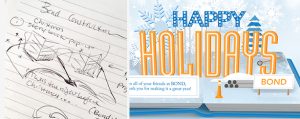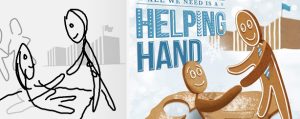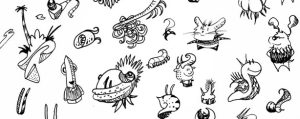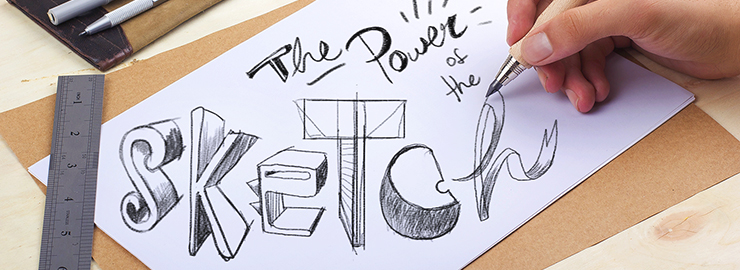Coming up with creative solutions involves exploring a lot of ideas. Sometimes the ideas flow like a raging river, making it a challenge to grab and hold on to one idea. Or worse, there’s a drought! Sketching is the tool that enhances the ideation process and guides you to compelling results.
When approaching a design problem, our goal is to create a solution that effectively solves the problem in a unique and memorable way. Novel solutions are what get you noticed. Getting there, though, is a journey in and of itself.
When approaching any design challenge, we first need to let it sink in. We immerse ourselves in the problem. We research and explore the world our client lives in to fully understand the factors surrounding the problem. Are we looking for a way for our client can reach a new audience base? Are we trying to simplify and communicate a complex idea? Regardless of the project, we do our research to have a solid foundation and understanding before we can create anything. Solid input will lead to the fantastic output.
SKETCH TO GENERATE TRULY NOVEL IDEAS
As our understanding of the project begins to take shape in our minds, ideas inevitably follow. Enter the sketch. Sketching—from the mind, to hand, to paper—is a fluid process that pulls the ideas out of your head and breathes life into them. Since an endless number of possible solutions exist to any problem, the goal is to push for the most interesting and effective. To get there, you’ll want to generate as many as you can! You can always scale back, so sketching is the time to push yourself.

The obvious solutions are just that—obvious. Those are the ideas that come up first, have likely been done before, and are void of the uniqueness we’re ultimately looking for. Getting them down on paper in a loose format allows you to generate a number of ideas in rapid succession, without spending too long on any one idea. The more you sketch, the more your ideas expand and push further from the obvious. To get the most out of your sketch phase:
1. GET ‘EM OUT OF YOUR HEAD
Sketch out any and every idea. Getting them down on paper ensures you won’t forget them later and frees your mind to travel across new and different ideas.
2. MAKE CONNECTIONS
The process of sketching serves as a springboard to new ideas. Seeing them in front of you allows you to make more connections. This can prove to be a natural process, but if not, simply look at what you’ve sketched and ask yourself how can you change that concept in any way.
3. NO FILTERS
It’s important not to censor yourself. It’s tempting to think an idea is dumb or won’t work, and therefore not sketch it out. At this stage, though, you never know where a “dumb” idea may lead you! The sketch phase is about generating as many different ideas as you can. Later on, you can asses which solutions will ultimately work for your project or not. The more material you have to work with now, the better later.
4. STAY LOOSE AND DON’T GET ATTACHED
Sketching allows you to take ideas further and further. By staying loose and not committing to any one idea at this stage, you can take your ideas to really different places. Perhaps you’re loving one idea, so now you can experiment with different compositions and ways of interpreting that core idea. Perhaps that core idea doesn’t encompass enough of what you’re ultimately trying to convey. Springboard off of it and try something else!
When you come back to your sketchbook later, you’ll have a number of great ideas to choose from to evolve further.
SKETCH TO QUICKLY COMMUNICATE YOUR IDEAS
As hired creatives, we are creating solutions for our client’s needs. We’ll often have ideas in our heads that may prove challenging to convey to clients (or even to fellow designers and colleagues on the project). Here is where a refined sketch can help the client envision your intended solution, without having to spend the time it would take to fully create that solution. This is equally great for exploring multiple options. We can present multiple sketches to get a sense of what the client is interested in before pursuing one idea.

Usually, the sketched idea is enough to get a sense from the client of whether it works for them or not. The best part of a discussion over sketches is that the project is still very loose, and thus very flexible and open to feedback. That conversation can then prompt new ideas from both the client and the creative team, which in turn often makes the solution much better. While I’m speaking primarily in terms of an illustration or design type of project, this holds true with websites too, in the flexible wireframe stage.
SKETCH TO STAY CREATIVE!
While sketching proves a very effective tool in solving problems, it need not be so functional. Sketching without purpose can be a freeing experience that allows your mind to relax and play. You may know this as ‘doodling’, which I’m an avid fan of! Any sort of playing is crucial in keeping our minds fresh and relaxed.

Play keeps us present and allows us to escape any tensions that may limit our creativity. For those of us in the visual arts, doodling as a form of play allows us to try out compositions, new shapes, patterns, and so much more. Keeping a sketchbook allows us to quickly jot down or draw those awesome ideas that come unexpectedly from this relaxed state as well.
The benefits of sketching cannot be understated. In an age where the computer dominates, loosen yourself up by going to the sketchbook first and unleash your creativity!
